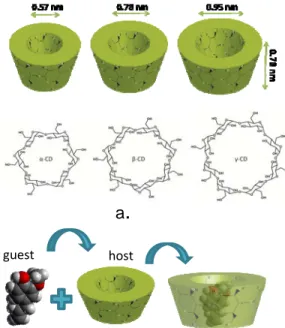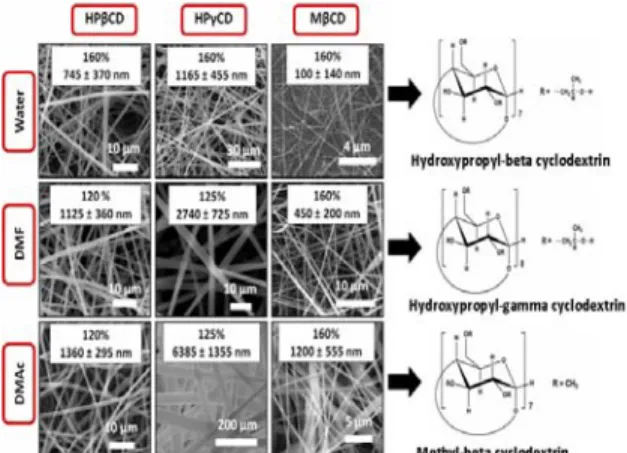Electrospun Nanofibers Functionalized with Cyclodextrins
and Their Potential Applications
Asli Celebioglu, Fatma Kayaci, Zeynep Aytac, Yelda Ertas, and Tamer Uyar
UNAM-Institute of Materials Science & Nanotechnology, Bilkent University, Ankara, 06800, Turkey tamer@unam.bilkent.edu.tr
OBJECTIVE
Our research mostly focuses on the electrospinning of functional polymeric nanofibers incorporating cyclodextrins (CD) and cyclodextrin inclusion complexes (CD-IC). Moreover, electrospinning of polymer-free CD and CD-IC nanofibers without using a carrier polymer matrix are also being performed successfully by our research group. The electrospun nanofibers functionalized with CD and CD-IC have potential applications in filtration, textile, food packaging, biotechnology as well as other advanced systems.
INTRODUCTION
Cyclodextrins (CD) are cyclic oligosaccharides consisting of α-(1,4)-linked glucopyranose units. The native CDs are named as α-CD, β-CD and γ-CD having 6, 7 and 8 glucopyranose units, respectively (Figure 1a), in addition, chemically modified CDs such as methyl-CD and hydroxypropyl-CD are also widely used due to their higher solubility and non-toxicity. CD molecules have truncated cone-shaped molecular structure and the CD cavity has relatively hydrophobic nature and due to the unique properties of CD, they form non-covalent host-guest inclusion complexes (IC) (Figure 1b) with variety of molecules such as antibacterials, drugs, antioxidants, flavors, essential oils, textile additives and pollutants, etc. By forming CD-IC, the shelf-life of the volatile textile/food additives can be increased and controlling the release of poorly soluble drugs can be achieved and toxic organic waste can be removed from the environment, etc. Hence, CD and CD-IC are quite applicable in many areas such as pharmaceuticals, functional foods, filters, cosmetics, textiles, etc.
Electrospinning is a facile and very cost-effective technique for producing nanofibers from a variety of materials such as polymers, polymer blends, sol– gels, composites, etc. In addition, incorporation of functional additives and nanoparticles, etc in the electrospun nanofibers can be achieved due to the design flexibility of the electrospinning process. Due to the very high surface area and nanoporous structure along with specific functionality, electrospun nanofibers and their mats are extremely applicable in biotechnology, membranes/filters, textiles, sensors, electronics, energy, environmental, etc.
Figure 1. (a) Chemical structure and approximate dimensions of α-CD, β-CD and γ-CD, (b) CD-IC.
APPROACH
In our studies, we produce electrospun polymeric nanofibers incorporating CD and CD-IC of several types of additives such as antibacterials, antioxidants, flavors, essential oils, drugs, etc. In addition, we successfully electrospun CD and CD-IC nanofibers without using a carrier polymer matrix.
RESULTS AND DISCUSSION
CD are very effective for the stabilization of volatile additives such as antibacterials, fragrances/flavors, essential oils, antioxidants and drugs by complexation and they provide slow release or controlled release as well as high temperature stability. Here, we prepared CD-IC of certain additives such as antibacterial (triclosan), fragrance/flavor (vanillin), essential oil (eugenol) and antioxidant (vitamin E). Then, these CD-ICs were blended with certain polymeric matrix and then electrospun into functional nanofibers/nanowebs (Figure 2) [1-3]. With this approach, functional nanotextile materials and/or food packaging materials can be obtained having
Cyclodextrin inclusion complex (CD-IC)
guest host
b
.
a
.
long-lasting functionality due to stabilization and sustained/controlled release of these additives by CD complexation. In addition, we produced CD-IC with certain drugs and we incorporated these CD-ICs in biocompatible/biodegradable polymeric nanofibers by electrospinning. The stabilization and controlled/sustained release of drug molecules from the electrospun nanoweb were studied. These drug-CD-ICs functionalized nanofibers/nanowebs would be extremely appealing in drug delivery systems, wound dressing and tissue engineering areas due to the exclusive properties obtained by combining the very large surface area of nanofibers with specific functionality of the CDs.
Figure 2. Schematic representations of the (a) formation of the vanillin/CD-IC, (b) electrospinning of the PVA/vanillin/CD-IC nanofibers.
In another study, we successfully performed the electrospinning of CD and CD-IC nanofibers without using a carrier polymer matrix. The electrospinning of nanofibers from non-polymeric systems such as CD is quite challenging. CD molecules are capable of self-assembly and form aggregates via intermolecular hydrogen bonding in their concentrated solutions and such aggregates present in the CD solutions can be effective for the electrospinning of CDs into nanofibers. For the first time we showed that electrospinning of CD nanofibers by itself without the use of a carrier polymer matrix is possible. We have investigated the electrospinning of nanofibers from three different chemically modified CD (HPβCD, HPγCD and MβCD) in three different solvent systems (water, DMF and DMAc) without using any carrier polymer matrix (Figure 3) [4-5]. We observed that the morphology and the diameter of the resulting electrospun fibers significantly vary with the type of CDs as well as the type of solvent systems used. In a different study, the electrospinning of polymer-free nanofibers from inclusion complexes of HPβCD with triclosan (HPβCD/triclosan-IC) was achieved successfully [6]. The antibacterial tests indicated that the HPβCD/triclosan-IC nanofibers were very effective against E.coli and S.aureus.
Figure 3. SEM images of HPβCD, HPγCD and MβCD nanofibers electrospun from water, DMF and DMAc.
CONCLUSION
We electrospun nanofibers functionalized with CD and CD-IC and investigate their potential applications in filtration, textile, food packaging, biotechnology. The electrospun CD nanofibers have unique properties due to their very high surface area along with specific functionality of the CD. KEYWORDS
cyclodextrin; electrospinning; nanofiber ACKNOWLEDGMENTS
Dr. T. Uyar acknowledges TUBITAK (project # 111M459 and 110M612) and EU FP7-PEOPLE-2009-RG Marie Curie-IFP7-PEOPLE-2009-RG (project # PIFP7-PEOPLE-2009-RG06-GA-2009- PIRG06-GA-2009-256428) for funding. State Planning Organization (DPT) of Turkey is acknowledged for the support of UNAM-Institute of Materials Science & Nanotechnology. F. Kayaci and A. Celebioglu acknowledge TUBITAK-BIDEB for the national graduate study scholarship.
REFERENCES
1. F. Kayaci and T. Uyar, “Solid Inclusion Complexes of Vanillin with Cyclodextrins: Their Formation, Characterization, and High-Temperature Stability” Journal of Agricultural and Food Chemistry, 59 (21),11772–11778, 2011.
2. F. Kayaci and T. Uyar, “Electrospinning of zein nanofibers incorporating cyclodextrins” Carbohydrate Polymers, 133, 641-649, 2012.
3. F. Kayaci and T. Uyar, “Encapsulation of vanillin/cyclodextrin inclusion complex in electrospun polyvinyl alcohol (PVA) nanowebs: Prolonged shelf-life and high temperature stability of vanillin” Food Chemistry, 133 (3), 641-649, 2012.
4. A. Celebioglu and T. Uyar, “Cyclodextrin Nanofibers by Electrospinning” Chemical Communications, 46(37), 6903-6905, 2010 (COVER). 5. A. Celebioglu and T. Uyar* “Electrospinning of Nanofibers from Non-Polymeric Systems: Polymer-free Nanofibers from Cyclodextrin Derivatives” Nanoscale, 4, 621-631, 2012.
6. A. Celebioglu and T. Uyar, “Electrospinning of Polymer-free Nanofibers from Cyclodextrin Inclusion Complexes” Langmuir, 27, 6218-6226, 2012.

